Photoreceptor coupling mediated by connexin36 in the primate retina
- PMID: 22457514
- PMCID: PMC3335500
- DOI: 10.1523/JNEUROSCI.4749-11.2012
Photoreceptor coupling mediated by connexin36 in the primate retina
Abstract
Photoreceptors are coupled via gap junctions in many mammalian species. Cone-to-cone coupling is thought to improve sensitivity and signal-to-noise ratio, while rod-to-cone coupling provides an alternative rod pathway active under twilight or mesopic conditions (Smith et al., 1986; DeVries et al., 2002; Hornstein et al., 2005). Gap junctions are composed of connexins, and connexin36 (Cx36), the dominant neuronal connexin, is expressed in the outer plexiform layer. Primate (Macaca mulatta) cone pedicles, labeled with an antibody against cone arrestin (7G6) were connected by a network of fine processes called telodendria and, in double-labeled material, Cx36 plaques were located precisely at telodendrial contacts between cones, suggesting strongly they are Cx36 gap junctions. Each red/green cone made nonselective connections with neighboring red/green cones. In contrast, blue cone pedicles were smaller with relatively few short telodendria and they made only rare or equivocal Cx36 contacts with adjacent cones. There were also many smaller Cx36 plaques around the periphery of every cone pedicle and along a series of very fine telodendria that were too short to reach adjacent members of the cone pedicle mosaic. These small Cx36 plaques were closely aligned with nearly every rod spherule and may identify sites of rod-to-cone coupling, even though the identity of the rod connexin has not been established. We conclude that the matrix of cone telodendria is the substrate for photoreceptor coupling. Red/green cones were coupled indiscriminately but blue cones were rarely connected with other cones. All cone types, including blue cones, made gap junctions with surrounding rod spherules.
Figures
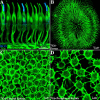
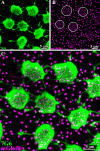
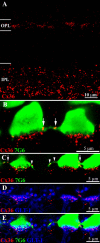
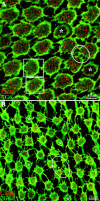



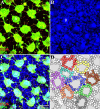
Similar articles
-
Analysis of rod/cone gap junctions from the reconstruction of mouse photoreceptor terminals.Elife. 2022 Apr 26;11:e73039. doi: 10.7554/eLife.73039. Elife. 2022. PMID: 35471186 Free PMC article.
-
The immunocytochemical localization of connexin 36 at rod and cone gap junctions in the guinea pig retina.Eur J Neurosci. 2003 Dec;18(11):2925-34. doi: 10.1046/j.1460-9568.2003.03049.x. Eur J Neurosci. 2003. PMID: 14656288
-
Characterization of connexin36 gap junctions in the human outer retina.Brain Struct Funct. 2016 Jul;221(6):2963-84. doi: 10.1007/s00429-015-1082-z. Epub 2015 Jul 15. Brain Struct Funct. 2016. PMID: 26173976
-
Multiple neuronal connexins in the mammalian retina.Cell Commun Adhes. 2003 Jul-Dec;10(4-6):425-30. doi: 10.1080/cac.10.4-6.425.430. Cell Commun Adhes. 2003. PMID: 14681052 Review.
-
The neuronal organization of the outer plexiform layer of the primate retina.Int Rev Cytol. 1984;86:285-320. doi: 10.1016/s0074-7696(08)60181-3. Int Rev Cytol. 1984. PMID: 6368448 Review.
Cited by
-
Retinal characteristics of the congenital disorder of glycosylation PMM2-CDG.J Inherit Metab Dis. 2013 Nov;36(6):1039-47. doi: 10.1007/s10545-013-9594-2. Epub 2013 Feb 22. J Inherit Metab Dis. 2013. PMID: 23430200
-
Fixation strategies for retinal immunohistochemistry.Prog Retin Eye Res. 2015 Sep;48:181-202. doi: 10.1016/j.preteyeres.2015.04.001. Epub 2015 Apr 17. Prog Retin Eye Res. 2015. PMID: 25892361 Free PMC article. Review.
-
Transducin-Deficient Rod Photoreceptors Evaluated With Optical Coherence Tomography and Oxygen Consumption Rate Energy Biomarkers.Invest Ophthalmol Vis Sci. 2022 Dec 1;63(13):22. doi: 10.1167/iovs.63.13.22. Invest Ophthalmol Vis Sci. 2022. PMID: 36576748 Free PMC article.
-
Function of cone and cone-related pathways in CaV1.4 IT mice.Sci Rep. 2021 Feb 1;11(1):2732. doi: 10.1038/s41598-021-82210-7. Sci Rep. 2021. PMID: 33526839 Free PMC article.
-
Analysis of the bystander effect in cone photoreceptors via a guided neural network platform.Sci Adv. 2018 May 9;4(5):eaas9274. doi: 10.1126/sciadv.aas9274. eCollection 2018 May. Sci Adv. 2018. PMID: 29750200 Free PMC article.
References
-
- Ahnelt PK, Kolb H. The mammalian photoreceptor mosaic-adaptive design. Prog Retin Eye Res. 2000;19:711–777. - PubMed
-
- Ahnelt PK, Kolb H, Pflug R. Identification of a subtype of cone photoreceptor, likely to be blue sensitive, in the human retina. J Comp Neurol. 1987;255:18–34. - PubMed
-
- Ahnelt P, Keri C, Kolb H. Identification of pedicles of putative blue-sensitive cones in the human retina. J Comp Neurol. 1990;293:39–53. - PubMed
-
- Attwell D, Borges S, Wu SM, Wilson M. Signal clipping by the rod output synapse. Nature. 1987;328:522–524. - PubMed
Publication types
MeSH terms
Substances
Grants and funding
LinkOut - more resources
Full Text Sources
Other Literature Sources
Miscellaneous
